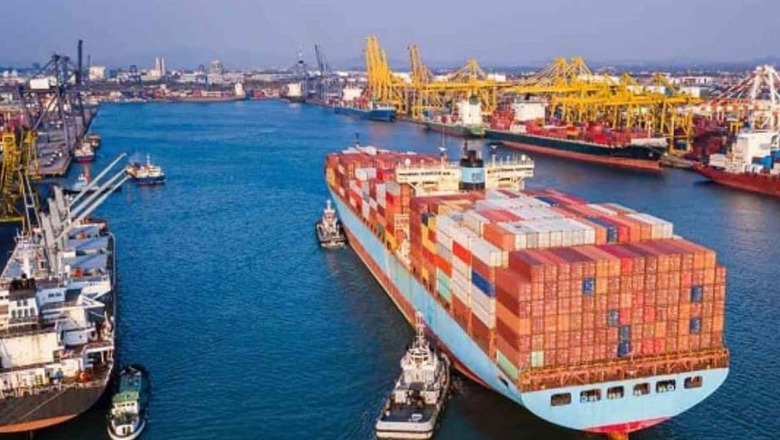
views
A blue economy is a term used to describe the economic activities that take place via oceans and seas. For a nation to become a blue economy, it must have a robust and modern maritime infrastructure. India has only recently begun focussing on building its blue economy in order to drive the country’s larger plan for development. While the strengthening of India’s maritime sector will definitely drive economic growth, it will also help India play a larger role on the world stage.
As geopolitical implications of becoming a major maritime power cannot be ignored, India is focussing on becoming a blue economy to expand its strategic heft in the world.
Prime Minister Narendra Modi on Tuesday launched maritime projects worth Rs 23,000 crore, and unveiled the long-term vision document for the country’s “blue economy”. The blueprint outlines strategic initiatives aimed at enhancing port facilities, promoting sustainable practices, and facilitating international collaboration.
India is infusing a lot of capital into its maritime sector. At the Global Maritime India Summit, PM Modi said India is on path to becoming the third largest economy in the world — an indication that his government sees maritime development playing a crucial role in achieving that milestone.
He also dedicated more than 300 Memorandums of Understanding (MoUs) worth more than Rs 7.16 lakh crore for global and national partnerships in the maritime sector. Perhaps, the biggest catch of the Global Maritime India Summit was the laying of the foundation stone of the Tuna-Tekra all-weather deep-draft terminal. This greenfield terminal will be built at a cost of over Rs 4,500 crore at Deendayal Port Authority in Gujarat in a public-private partnership (PPP) mode. It is expected that this terminal will act as a hub for international trade and maritime transit, capable of handling next-generation vessels.
The terminal is also expected to become a gateway for trade with India via the IMEC corridor linking Europe, the Middle East and India. Announced during the G20 leaders’ summit in New Delhi, the IMEC corridor is a landmark project undertaken to drastically improve India’s maritime economy and interaction with the world. Despite the war in West Asia, PM Modi has invited international players to be part of the ambitious corridor, showing the project is still very much on for India.
The PM also said India is poised to become one of the top five shipbuilding nations in the coming decade. The development of India’s maritime infrastructure has been linked with the country’s goal of becoming a developed nation by 2047.
What India is Doing Right with its Maritime Sector
India has made some giant strides in uplifting and strengthening its maritime economy and putting itself on the global transit map. On Sunday, the inauguration of the Adani Group’s Vizhinjam transshipment container port placed India among the few nations capable of handling the world’s largest ships and containers. This port, and the continuous addition of maritime infrastructure, will help India grab a larger share of global maritime trade, which is currently dominated by China. India’s emergence as an international maritime hub is a natural piece to the democratic world shifting supply chains away from China.
Besides, the Modi government is working on a plan called ‘Maritime India Vision 2030’ that seeks to develop world-class mega ports, transshipment hubs and modernise infrastructure at an estimated investment cost of Rs 1.25 trillion. In July, Union minister for ports, shipping and waterways, Sarbananda Sonowal had said the Centre has identified investment opportunities worth more than Rs 10 lakh crore in the maritime sector – expected to generate no less than 15 lakh new jobs.
In June, the World Bank’s Logistic Performance Index (LPI) Report had revealed how India is transforming not just its ports and maritime links with the world, but also its logistics sector.
• India has moved up to 22nd rank in the global rankings on the “International Shipments” category from the 44th position in 2014.
• India has also secured the 38th rank on the LPI score.
• In 2015, the capacity of India’s 12 major ports stood at 871 million metric tonnes (MMT), but has now risen to 1,617 MMT.
• At the same time, the total capacity of Indian ports has gone up from about 1,560 MMT in 2015 to more than 2,600 MMT now.
• From 2015 to 2022-23, the value of operationalisation of public-private partnership projects in major ports has risen by 150% from Rs 16,000 crore to Rs 40,000 crore.
The strengthening of India’s maritime sector is also being propelled by crucial legislation passed by the Modi government in recent years. Their goal has been to reform and infuse new energy in the sector. For instance, the Major Port Authorities Act, 2021 grants greater autonomy to major ports of the country, while the Indian Vessels Act, 2021 brings uniformity in law and standardised provisions across all inland waterways in the country. Similarly, the Marine Aids to Navigation Act, 2021 ensures increased safety and efficiency in vessel traffic services as well as training and certification at par with international standards.
In fact, it was in 2020 that the government unveiled the ‘Maritime India Vision 2030’.
While the India-Middle East-Europe Corridor is now the buzzword, New Delhi has been careful not to place all its eggs in one basket. In September, Sonowal suggested that India and Russia are soon going to begin operations on the Eastern Maritime Corridor (EMC). This route connects the Indian port city of Chennai with the far eastern Russian city of Vladivostok. The EMC is estimated to reduce the time required to transport cargo between Indian and Russian Ports of Far-East Region by up to 16 days. At present, the transit between India and Russia by sea takes 40 days.
Given the pace and scale at which the maritime sector is being modernised and expanded, India will soon be a bigger player that has the capacity to rival China on the global maritime stage. The maritime sector will also contribute significantly to India’s economy and its desire to become a developed nation by 2047.



















Comments
0 comment